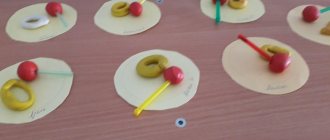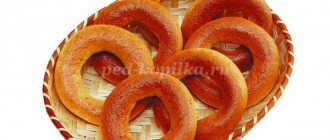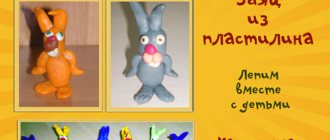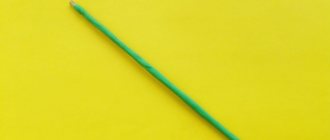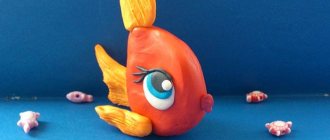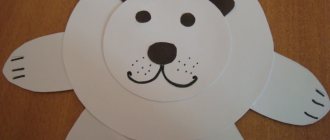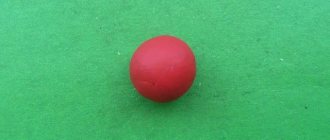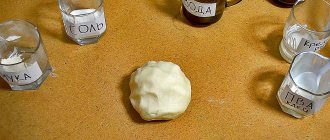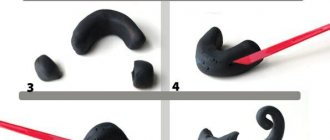Modeling lesson “Mushrooms in a clearing” in the second junior group
Natalya Mamon
Modeling lesson “Mushrooms in a clearing” in the second junior group
Artistic and aesthetic development
modeling in the second junior group.
Topic: “Mushrooms in the clearing.”
Tasks:
Teach children to sculpt mushrooms in a constructive way from two parts (leg, cap).
Show techniques for modeling a mushroom cap: rolling out a ball and flattening it into a flat cake or disk.
Arouse interest in creating a collective composition.
Develop fine motor skills.
Cultivate curiosity and accuracy.
Materials and equipment:
plasticine brown, orange, yellow; planks; stacks, containers for plasticine; two - three mushrooms, sculpted in advance; compositional basis - a model of an autumn forest with a stump; musical accompaniment during the practical part with the sounds of the forest and the song “Bus” by E. Zheleznova, etc.
Preliminary work:
conversation about mushrooms, looking at illustrations, making in advance a model of the basis of a clearing in the autumn forest with mushrooms and stumps.
Progress of the lesson:
1. Org. moment
Educator: - Guys, guess the riddle!
In the forest under the Christmas tree there is a baby -
Just a hat and a leg. (Fungus.)
Educator: - Well done! I invite you to go on a trip to the autumn forest today!
2. Main part
- Guys, what can you go on a trip with? (children’s options: by bus, by friendship train, etc.)
To the music “We are sitting on the bus” by E. Zheleznova or “Locomotive” (depending on the wishes of the children), the teacher and the children go into the autumn forest. The teacher shows the children a model of a clearing with mushrooms near a tree stump in the autumn forest.
Educator: - Children, look what beautiful mushrooms the stump has grown in a forest clearing. Let's take a closer look at the fungus. What does a mushroom have? (Stem and cap).
Examining a model of a mushroom. Teacher's story.
Show progress.
Educator: - Do you want to sculpt a lot - a lot of mushrooms? (children's answers).
Let's please the forest animals. Let's stick some mushrooms and plant them in the clearing near the stump.
The teacher shows the method of sculpting:
-The fungus has a long and light stalk. It can be sculpted from white or yellow plasticine. To do this, we take a piece of plasticine and roll out a column in our palms - like this (forward - back). The leg is ready!
The cap of the fungus is large and round. It can be molded from red, orange, brown plasticine. For the hat, we take a piece of red, orange or brown plasticine and roll out the ball in a circular motion.
Then flatten it to form a flat cake. The hat is ready!
Carefully attach the cap to the stem of the mushroom. The mushroom is ready! Now we carefully attach it to the clearing.
Educator: - Before we start work, let's stretch our fingers.
Finger game “A fox with a box ran through the forest”
She ran in a forest (we walk along the table with our middle and index fingers)
Fox with a box. (cup-shaped palms)
- What's in the box?
— Forest mushrooms, (put your palm on your fist)
Mushrooms - milk mushrooms
For my son, for my daughter. (Press both hands to your chest)
Practical part. Individual work as the task progresses.
Educator:
- Let's get to work guys.
As the lesson progresses, the teacher helps the children with advice, guiding questions, and individual demonstrations of modeling techniques.
At the end of the lesson, the children place their mushrooms in the clearing near the stump.
3. Reflection. Summarizing. Exhibition of works
The teacher praises the children:
- Well done boys! What beautiful mushrooms you got, and so many! How the forest animals will rejoice! Did you enjoy our trip to the autumn forest! (children's answers)
Lesson summary for visual arts (modeling) “Mushroom clearing”
has been working in kindergarten for 11 years, actively participates in the methodological work of preschool educational institutions and at the municipal level, participating in open screenings of classes and in pedagogical councils, in city methodological associations and municipal projects. Ekaterina Aleksandrovna effectively uses innovative gaming technologies (Nikitin Cubes, Dienesh blocks, Cuisenaire sticks, etc.) and modern communication tools in her work with children, in which courses on ICT and Internet technologies helped her a lot.
Lesson summary for visual arts (modeling) “Mushroom clearing”
,
teacher, first qualification category.
Second junior group of kindergarten
Program tasks: to train children in rolling out (mushroom stems) and rolling (balls for hats), introduce the technique of flattening (hat); consolidate the skills and rules of working with plasticine. Develop cognitive motivation and desire to sculpt. Cultivate responsiveness, kindness, and willingness to help.
“Children’s goal”: help the squirrel make provisions for the winter.
Difficulty: how to make mushroom caps?
New knowledge: flattening technique, words “flat”, “mushroom clearing”.
Educational task: teach techniques for flattening using palms and fingers, connecting parts of a mushroom.
Forms of children's activity: cognitive and speech activity in the form of dialogue, modeling, finger play, outdoor physical education game.
Demonstration material: toy squirrel, dummies of mushrooms, sample of finished work.
Handouts: soft brown and white plasticine, stacks, modeling boards, “green meadow” stand, wet wipes.
| Parts of the lesson | Educator | Children | Notes |
| 1.Org. moment | A guest has come to us, try to guess the riddle and then you will find out who she is: “I walk around in a fluffy fur coat, I live in a dense forest, I gnaw nuts in a hollow on an old oak tree.” | Children's answers. | |
| 2.Motivation, actualization | The squirrel liked that you quickly guessed the riddle. What is our squirrel? Where she lives? What does a squirrel eat? Guys, our squirrel is very upset, what do you think? She is upset because the magpie stole all her winter supplies. Let's help the squirrel. Do you want to make mushrooms for her? These are the mushrooms the squirrel needs (shows dummies and samples). The fungus has a stalk and... Let's look at the leg. What color is the leg? How much plasticine do you need to take? How will we roll out the plasticine? | - Fluffy, small, gray. Lives in the forest. Lives on a tree, in a hollow. Eats nuts, mushrooms, berries. - Someone offended her. Children empathize with the squirrel and express a desire to help her. ...(hat). — The leg is white, light. - Separate a little from the piece. - We will roll out the column. | At the first and second stages, children practice while standing. You can include slide viewing in your lesson. The known method of action is repeated. |
| 3. Difficulty | Guys, do you know how to sculpt a hat? How do we mold her? What kind of cap does the fungus have? | - No. Children make guesses: -Make a “circle”, roll into a ball. -The hat is round, looks like a ball. | |
| 4.Discovery of new knowledge | The teacher suggests taking a closer look at the dummies, noting that their hats are flat and look like “pancakes, pancakes, buns.” How to flatten a ball? Who can guess? The teacher shows how to sculpt a hat and connect it to the stem. Your fingers probably wanted to play? | Squeeze the ball tightly between your palms and press with your fingers. Children comment on the show. Finger gymnastics. “This little finger went into the forest. This finger found a mushroom. I began to clean this finger. That finger began to fry. He took this finger and ate it. That’s why I got fat.” | The word “flatten” is introduced due to its figurative and sound similarity to the named words. |
| 5.Introduction of new knowledge into the knowledge system | The teacher observes the children’s work, advises them to help each other and reminds children who cannot cope with how to sculpt and flatten. Playing the game “Repeat after the squirrel” with the squirrel | The children begin to sculpt. The children finish their work and wipe their hands. | Children who quickly master a new technique can make several mushrooms. Outdoor play is an emotional release |
| 6.Reflection | The teacher suggests putting all the mushrooms on a stand - a clearing - and admiring your mushrooms. - What did we sculpt today? -Who did we help? — Was it difficult to figure out how to sculpt the hats? — Did our mushrooms turn out beautiful? - Why do our hats look like real ones? - What is the squirrel happy about? Now she has supplies for the winter. She thanks you: “Thank you, children!” | — We made mushrooms. - We helped the squirrel. — The hats look like pancakes, like buns. — The mushrooms are beautiful, like real ones. -We learned how to flatten balls. “We helped her make provisions for the winter.” Children help the teacher remove the modeling material and play with the squirrel. | Reflection in early preschool age is carried out with the help of a teacher. At the end of the lesson, children can play with the character. |
Get text
Mushrooms on a stump. Modeling in the younger group
Modeling
(collective composition)
“Mushrooms on a stump”
Program objectives
. Teach children to sculpt mushrooms in a constructive way from two parts (leg, cap). Show techniques for modeling a mushroom cap: rolling out a ball and flattening it into a flat cake or disk. Pay attention to the need for a strong and neat connection of the parts. Arouse interest in creating a collective composition “Mushrooms on a Stump”. Develop abilities for shaping and composition. Cultivate curiosity and accuracy.
Equipment
.
Plasticine brown, red, orange, white, yellow; planks; napkins; containers for plasticine; two - three mushrooms, sculpted in advance; compositional basis; little animals - toys; treat - sweet mushrooms; basket. Progress of the lesson.
Children , I will tell you a riddle,
and you try to guess it.
In the forest under the Christmas tree there is a baby - only a hat and a leg. (Fungus.) Well done! I invite you to the forest school for a lesson. Aunt Owl will tell the tale “About Mushrooms”.
So, attention.
(Show video) You saw how the animals completed their homework. And now
we will go with you to the forest
along a flat path Along a level path, along a level path, Our feet walk along a level path. One, two, one, two, one, two, our feet walk. Over the pebbles, over the pebbles, over the pebbles, Over the pebbles, into the hole - bang! (Children stand up) Here we are. And here is the clearing.
Shadow - shadow, shadow, There is a stump in the middle of the clearing.
And the guys growing on the stump are thin-legged honey mushrooms. They are guarding the stump, standing. They look at everyone from above. Children, look how beautiful these mushrooms are - honey mushrooms
grew on a stump.
And you want to sculpt a lot, a lot of mushrooms. After all, honey mushrooms grow as a whole family. But first, let's look at the fungus. What does a mushroom have? (Stem and cap).
Right!
The fungus has a long and light stalk
.
It can be sculpted from white or yellow plasticine. To do this, we take a piece of plasticine and roll out a column in our palms - like this (forward - back). The leg is ready! The cap
of the fungus is
large, round and bright.
It can be molded from red, orange, brown plasticine.
For the hat, we take a piece of bright plasticine and roll out the ball in a circular motion. Then we flatten it, like this, to make a flat cake. The hat is ready! The cap of the fungus rests on the stem. Carefully fasten the cap and stem together like this. The mushroom is ready! Now carefully attach it to the stump. Children, let's please the forest animals. Let's stick some mushrooms and plant them on a stump. Before we get started, let's play with our fingers. Finger game “A fox ran through the forest with a box”
A fox ran through the forest with a box.
- What's in the box? - Forest mushrooms, Mushrooms - milk mushrooms For a son, for a daughter. Let's get to work. (Children are working.) What color is the cap and stem of your fungus? Well done boys!
What beautiful mushrooms you have created!
Look how many mushrooms there are on our stump! Forest animals immediately came running to our stump. What animals came running to the clearing? (Bear, fox, squirrel...) They really liked your mushrooms. For this they prepared a sweet treat for you
.
Here it is - these are mushrooms
. Let's thank the animals for the treat. (Thank you!)
